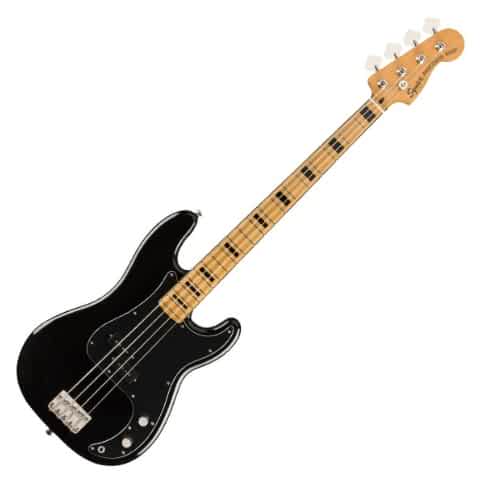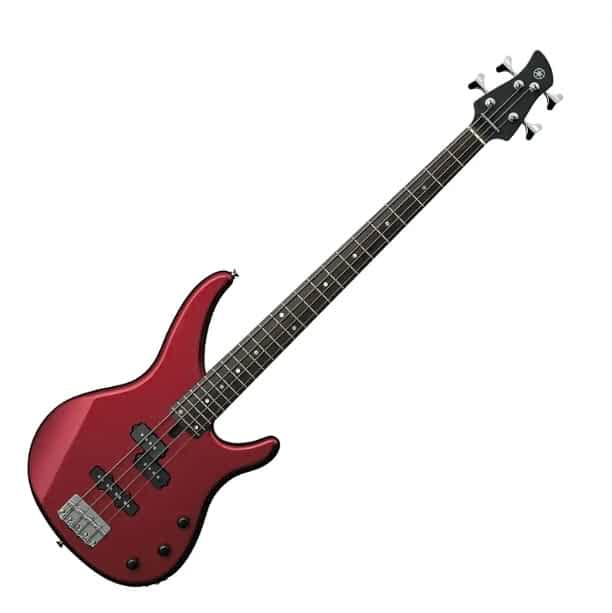Best Overall
Bass Guitar
-
Overall: 9/10
-
Best Feature: '70s-inspired design
-
TedScore™: 9/10
Best Bass
Guitar Under 300
-
Overall: 8/10
-
Best Feature: Maple neck with a rosewood fingerboard
-
TedScore™: 8/10
Best High-end
Bass Guitar
-
Overall: 9/10
-
Best Feature: Maple/walnut neck with rosewood fingerboard
-
TedScore™: 9/10
What are the strings on a Bass Guitar? It’s a common question…
In this article, we’ll explore the world of bass guitar strings and discover the secrets behind creating those groovy basslines that get your head bobbin’ and your feet tappin’.
So grab your bass guitar, and let’s begin!
Bass Guitar Strings
Bass guitar strings are an essential component of the bass guitar and are responsible for creating the sound and feel of the music.
The strings are usually made of steel or nickel and come in different thicknesses or gauges, which affect the tension and the sound of the bass string materials they produce.

Bass guitar strings create different notes and chords by pressing down on the strings at various places on the fretboard.
Correct tuning of bass guitar strings is crucial to ensure the instrument produces the correct pitch and sounds in tune with other instruments.
Coated vs Uncoated Bass Strings
Coated and uncoated bass strings refer to the different types of protective coatings applied to the strings.
Coated bass strings have a polymer layer, like Teflon or other similar materials, providing an added layer of protection against rust, dirt, and moisture. This added protection can significantly increase the lifespan of the strings.
The coating also provides a smoother playing surface, reducing finger noise and enhancing the instrument’s overall tone.
On the other hand, uncoated bass strings lack this protective layer and are more susceptible to natural wear and tear over time.
While uncoated strings may offer a slighter, more natural, and raw sound, coated strings provide better durability and longevity, making them a preferred choice for players looking for extended string life and consistent performance.
The Order of the Strings
Bass guitars typically have four strings, although some models may have five or six strings. The strings on a four-string bass guitar are ordered from the thickest to the thinnest.
The thickest string upright bass here is the E string, followed by the A, D, and G strings. This order is important to remember when you’re tuning your bass guitar or playing chords.
Gauge and Tension of Strings
The gauge of a string refers to its thickness, affecting the string’s tension. This means thicker strings have higher tension.
Most bass guitar strings come in a medium gauge, which balances tone and playability well. However, some bassists prefer thicker or thinner strings depending on their playing style and preferences.
The tension of the strings also affects the sound of the bass guitar. Higher tension strings produce a brighter and more articulate sound, while lower tension strings have a warmer and more mellow sound.
Finding the right balance between tension and gauge is important to achieve the tone you want.
Notes and Chords
Now that you know the basics of the bass guitar strings, it’s time to learn about notes and chords. As mentioned earlier, the bass guitar typically has four strings tuned to E, A, D, and G.
Tone
Each string produces a different tone, and the tuning allows you to play a wide range of notes and chords.
The musical alphabet consists of seven letters: A, B, C, D, E, F, and G. These letters represent the different notes you can play on the bass guitar.
Different Octaves
Each note can be played at different octaves, meaning you can play the same note at a higher or lower pitch.
You’ll need to know about fingerings and frets to play chords on the bass guitar.
A chord is a combination of two or more notes played together, and you can play many different chords on the bass guitar.
Common bass guitar chords
Common bass guitar chords include the major, minor, and seventh chords. Bassists use different techniques to produce different sounds and effects when playing bass guitar notes and chords.
For example, fingerpicking or slapping can create different tones and rhythms. You can also experiment with different fret positions to produce different sounds.
When playing notes and chords on the bass guitar, it’s important to pay attention to the bass clef.
This is the symbol used to indicate the range of notes that the bass guitar can play. By understanding the bass clef, you can read sheet music and play along with other musicians.
How to Choose the Best Guitar Strings
Choosing bass guitar strings that suit your playing style is essential for achieving the desired tone and feel. Here are some factors to consider when selecting bass guitar strings:
String Gauge
The string gauge refers to the thickness of the strings.
Lighter gauge strings are generally easier to play, provide a brighter tone, and are suitable for players who prefer fast playing styles or have a lighter touch.
On the other hand, heavier gauge strings offer a thicker, fuller tone and are more suitable for players who prefer aggressive playing styles or play with heavier touch bass strings.
Playing Style
Consider your preferred playing style. Different genres and techniques may require specific string characteristics.
For example, if you play funk, slap bass, or other styles requiring percussive playing, you may opt for brighter-sounding strings that emphasize the midrange and treble frequencies.
If you play rock or metal and seek a deep, heavy tone, you may prefer strings with a strong, low-end response.
Material
Bass guitar strings are typically made of stainless steel, nickel-plated steel, or flatwound/groundwound.
Stainless steel strings tend to have a bright, cutting tone and provide a good balance of brightness and warmth. Nickel-plated steel strings offer a warmer, smoother sound and are favored by many players.
Flatwound strings have a smooth surface, producing a mellow, vintage tone, while groundwound strings offer a compromise between roundwound strings and flatwound strings.
Durability
Consider the durability of the strings. Some strings may last longer before breaking or losing their tone, which can be beneficial if you play frequently or aggressively.
However, keep in mind that strings that offer greater durability may sacrifice some tonal qualities.
Experimentation
Ultimately, the best way to find the perfect strings for your playing style is to try different brands, string gauges, and materials. Experiment with various combinations until you find the comfortable strings and produce the desired tone.
Our Recommended Bass Guitars for Beginners
Squier Classic Vibe '70s Precision Bass MN, Black

FEATURES:
- 70s-inspired design
- Maple neck for smooth playability
- Vintage-style split single-coil pickup for authentic P-Bass tone
- Excellent value for money
- Classic aesthetics and authentic vintage vibe
- Versatile sound with a wide range of tones
- May require occasional setup adjustments for optimal playability
- Heavier weight compared to some other bass guitars
When you click ‘Check Price’, you’ll see there are loads of great places to buy this item. Our personal favorite is Sweetwater for the US, and Thomann and Gear4Music for the UK & Europe.
They are the largest music retailers, with excellent customer service, competitive prices, really fast shipping, and the longest guarantees.
The professional musician who wrote this article combined many things,
from the product build, manufacturer’s reputation through to feedback
from other users, to create our famous TedScore™.
Yamaha TRBX174 Electric Bass Guitar, Red Metallic

FEATURES:
- Solid basswood body
- Maple neck with a rosewood fingerboard
- Dual pickup configuration with a split-coil P-style pickup and a single-coil J-style pickup
- Versatile tone options with the dual pickup configuration
- Comfortable playability with the maple neck and rosewood fingerboard
- Solid build quality and durability for long-lasting performance
- Limited colour options compared to other models
- The stock pickups may not offer as much clarity and definition as higher-end models
When you click ‘Check Price’, you’ll see there are loads of great places to buy this item. Our personal favorite is Sweetwater for the US, and Thomann and Gear4Music for the UK & Europe.
They are the largest music retailers, with excellent customer service, competitive prices, really fast shipping, and the longest guarantees.
The professional musician who wrote this article combined many things,
from the product build, manufacturer’s reputation through to feedback
from other users, to create our famous TedScore™.
Ibanez SR1340B Premium, Dual Shadow Burst Flat

FEATURES:
- Mahogany body construction
- Maple/walnut neck with rosewood fingerboard
- Bartolini BH2 pickups
- Versatile tone options
- Excellent build quality
- Comfortable to play for extended periods
- Relatively high price
- Limited colour options
When you click ‘Check Price’, you’ll see there are loads of great places to buy this item. Our personal favorite is Sweetwater for the US, and Thomann and Gear4Music for the UK & Europe.
They are the largest music retailers, with excellent customer service, competitive prices, really fast shipping, and the longest guarantees.
The professional musician who wrote this article combined many things,
from the product build, manufacturer’s reputation through to feedback
from other users, to create our famous TedScore™.
Taking Care of Bass Guitar Strings
When it comes to taking care of your bass guitar strings, you can do a few things to help them last longer and maintain their playability.
Here are some tips to keep in mind:
1. Clean your strings regularly
One of the most important things you can do to extend the life of your bass guitar strings is to clean them regularly.
Sweat, dirt, and grime can build up on the strings over time, which can cause them to lose their brightness and playability.
You can use a soft cloth or a string cleaner to clean your strings. Simply wipe down the strings after each use to remove dirt or sweat.
2. Choose the right strings for your bass
Choosing the right strings for your bass guitar can also help to extend their life. There are many different types of strings available, each with their unique sound and feel.
When choosing strings, consider factors such as the gauge, the core and winding materials, and the overall tone you’re looking for.
3. Store your bass properly
Proper storage is also important when it comes to taking care of your bass guitar strings.
Store your bass in a cool, dry place, away from direct sunlight and extreme temperatures. This will help to prevent the strings from becoming brittle or damaged.
4. Change your strings regularly
No matter how well you care for your bass guitar strings, they will eventually wear out and lose their tone.
To maintain optimal playability and tone, it’s recommended that you change your strings every 3-6 months, depending on how often you play.
By following these tips, you can help to extend the life of your bass guitar strings and ensure that they remain playable and sound great for years to come.
What Are The Strings On A Bass Guitar:
A Recap
Yay! You now know all about the strings on a bass guitar. You’ve learned about the types of strings available, how to choose the right strings for your playing style, and how to tune your bass guitar.
Remember, the strings on your bass guitar are one of the most important aspects of your instrument. They can greatly affect the sound and playability of your bass, so it’s important to choose the right strings for your needs.
Whether you’re a beginner or an experienced player, a set of bass guitar strings is perfect for you.
Take some time to experiment with different types of strings and find the ones that work best for your playing style and musical preferences.
With the right strings and a little bit of practice, you’ll be well on your way to becoming a great bass player. So go ahead and rock out with your bass guitar, and don’t forget to have fun!
Before you go…
Discover the Bass Guitar For Small Hands in our list of top picks. From comfortable necks to stylish designs, find the perfect instrument to help you rock out like a pro!
FAQ's
The four strings on a bass guitar are usually tuned to E, A, D, and G. Each string is thicker and has less tension than the strings on a guitar.
The bass guitar strings are arranged from thickest to thinnest, with the lowest-pitched string (E) being the thickest and the highest-pitched string (G) being the thinnest.
To know what string to play on bass, you need to read the music notation or tablature for the song you are playing. The notation will indicate which string to play and at what fret.
The 5th string on a bass guitar is an additional string that is lower in pitch than the E string. It is usually tuned to B or C, depending on the player’s preference.











While durability and material matter, I think the emphasis should really be on how the strings affect your playing style. I’ve seen too many beginners get hung up on coated vs uncoated without considering how it impacts their ability to learn and play. What’s the panel’s take on this? Especially interested to hear back from Hugh Richardson.
i always thought that the heavier the strings, the better the sound. but reading about gauge and tension, maybe i got it all wrong. has anyone else experimented with different gauges to find what works best?
Very informative! The section on gauge and tension clarified a lot for me.
Hey Hugh Richardson, I’m totally new to bass and was wondering if coated strings make a big difference in sound? Trying to find the best ones without breaking the bank here.
Coated strings can last longer and feel smoother, which might be good for a beginner. Worth a try to see if you like them!